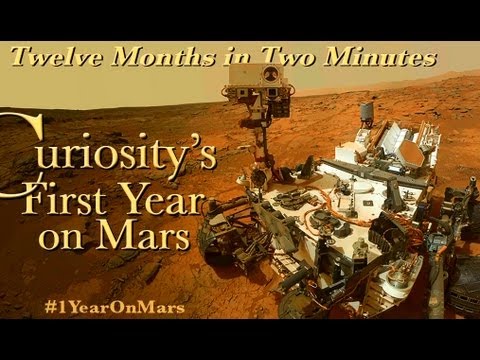more at
“Here is a rover’s eye view of driving, scooping and drilling during Curiosity’s first year on Mars, August 2012 through July 2013.”
Public domain film from NASA.
The film was silent. I have added music created by myself using the Reaper Digital Audio Workstation and the Independence and Proteus VX VST instrument plugins.
Curiosity is a car-sized robotic rover exploring Gale Crater on Mars as part of NASA’s Mars Science Laboratory mission (MSL).
Curiosity was launched from Cape Canaveral on November 26, 2011, at 10:02 EST aboard the MSL spacecraft and successfully landed on Aeolis Palus in Gale Crater on Mars on August 6, 2012, 05:17 UTC. The Bradbury Landing site was less than 2.4 km (1.5 mi) from the center of the rover’s touchdown target after a 563,000,000 km (350,000,000 mi) journey.
The rover’s goals include: investigation of the Martian climate and geology; assessment of whether the selected field site inside Gale Crater has ever offered environmental conditions favorable for microbial life, including investigation of the role of water; and planetary habitability studies in preparation for future human exploration.
Curiosity’s design will serve as the basis for a planned unnamed 2020 Mars rover mission. In December 2012, Curiosity’s two-year mission was extended indefinitely.
In April and early May 2013, Curiosity went into an autonomous operation mode for approximately 25 days during Earth-Mars solar conjunction. During this time, the rover continued to monitor atmospheric and radiation data, but did not move on the Martian surface…
Curiosity comprised 23% of the mass of the 3,893 kg (8,580 lb) Mars Science Laboratory (MSL) spacecraft, which had the sole mission of delivering the rover safely across space from Earth to a soft landing on the surface of Mars. The remaining mass of the MSL craft was discarded in the process of carrying out this task.
Dimensions: Curiosity has a mass of 899 kg (1,980 lb) including 80 kg (180 lb) of scientific instruments. The rover is 2.9 m (9.5 ft) long by 2.7 m (8.9 ft) wide by 2.2 m (7.2 ft) in height.
– Power source: Curiosity is powered by a radioisotope thermoelectric generator (RTG), like the successful Viking 1 and Viking 2 Mars landers in 1976.
– Radioisotope power systems (RPSs) are generators that produce electricity from the decay of radioactive isotopes, such as plutonium-238, which is a non-fissile isotope of plutonium. Heat given off by the decay of this isotope is converted into electricity by thermocouples, providing constant power during all seasons and through the day and night. Waste heat can be used via pipes to warm systems, freeing electrical power for the operation of the vehicle and instruments. Curiosity’s RTG is fueled by 4.8 kg (11 lb) of plutonium-238 dioxide supplied by the U.S. Department of Energy, packed in 32 cubes.
Curiosity’s power generator is the latest RTG generation built by Boeing and Idaho National Laboratory, called the “Multi-Mission Radioisotope Thermoelectric Generator” or MMRTG. Based on classical RTG technology, it represents a more flexible and compact development step, and is designed to produce 125 watts of electrical power from about 2,000 watts of thermal power at the start of the mission. The MMRTG produces less power over time as its plutonium fuel decays: at its minimum lifetime of 14 years, electrical power output is down to 100 watts. The power source will generate 9 MJ (2.5 kWh) each day, much more than the solar panels of the Mars Exploration Rovers, which can generate about 2.1 MJ (0.58 kWh) each day. The electrical output from the MMRTG charges two rechargeable lithium-ion batteries…
The general sample analysis strategy begins with high resolution cameras to look for features of interest. If a particular surface is of interest, Curiosity can vaporize a small portion of it with an infrared laser and examine the resulting spectra signature to query the rock’s elemental composition. If that signature is intriguing, the rover will use its long arm to swing over a microscope and an X-ray spectrometer to take a closer look. If the specimen warrants further analysis, Curiosity can drill into the boulder and deliver a powdered sample to either the SAM or the CheMin analytical laboratories inside the rover. The MastCam, Mars Hand Lens Imager (MAHLI), and Mars Descent Imager (MARDI) cameras were developed by Malin Space Science Systems…
Curiosity… is the fourth NASA unmanned surface rover sent to Mars since 1996. Previous successful Mars rovers are the Sojourner rover from the Mars Pathfinder mission (1997), the Spirit rover (2004-2010) and the Opportunity rover (2004–present)…

